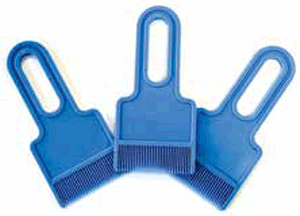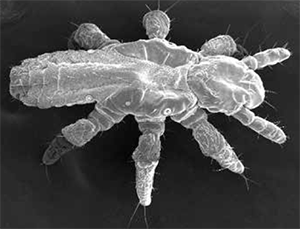The condition
What are head lice?
‘Head lice’ are infestations of the Pediculus humanus capitis species. Infestations are common, particularly in school-aged children, occur worldwide and affect people of all ages and socioeconomic groups.
How are head lice diagnosed?
The lice may be seen on the scalp or in the hair of an infected person. In about half of people infested with head lice there will be scratching in response to itch. Any person who has been in contact with someone who has head lice should also be examined for infestations.
Wet combing for the detection of head lice can be used for diagnosis. The process takes 5–15 minutes, depending on the length and thickness of the person’s hair. Combs for the detection of head lice should have a tooth spacing of less than 0.3 mm (Figure 1) in order to trap the head lice and their nymphs (Figure 2) effectively. Some authorities recommend plastic (not metal) combs for the detection of lice. The mechanics of combing the hair for the detection of head lice are described in the ‘intervention’ section.

Figure 1. Head lice removal comb

Figure 2. Nymph of head louse
Are there any other considerations?
The hair of all family members should be checked at the same time. Family members and contacts only require treatment if they are found to have live lice in their hair.
The intervention
How to perform wet combing
To perform wet combing using the method described in the trial by Hill et al (see key references):
1. Wash the hair using an ordinary shampoo
2. Apply ample conditioner to aid straightening and detangling
3. Straighten and detangle the wet hair using a wide-toothed comb
4. Once the comb moves freely through the hair without dragging, switch to a head lice detection comb
5. Make sure the teeth of the comb slot into the hair at the roots, with the deeply bevelled edge lightly touching the scalp, and draw the comb down to the ends of the hair with every stroke
6. Check the comb for lice after each stroke, and remove them by wiping or rinsing the comb
7. Work through the hair section by section
8. Rinse out the conditioner. Depending on the length of hair, this may have taken 10 minutes (for short hair) to 30 minutes (for longer hair)
9. Repeat the combing procedure in the wet hair to check for any lice that might have been missed the first time.
There are variations described using commercial solutions or using conditioner on dry hair.
All methods advocate repeating the procedure regularly (from every 2 days to every week) until no further lice are found. Most methods suggest repeating regularly for at least 2 weeks. The method used in the trial is to repeat the wet combing procedure every 3 days, until on four consecutive occasions no head lice are detected.
What should I consider?
Wet combing can be used to treat any person with head lice infestations. Groups it may be particularly suited to include:
- those with insecticide resistant infestations
- pregnant and breastfeeding women
- babies
- people with allergies or open scalp wounds
- people with asthma
- people who are reluctant to use insecticides.
Considerations
- Any method used needs to be done diligently and pedantically to be effective – the term ‘nit-picking’ really applies here
- No method is 100% effective
- Repeated treatments are necessary, regardless of the method used
- No method guarantees avoiding recurring head lice infestations.
Adverse effects
No serious adverse effects have been reported.
Evidence
National Health and Medical Research Council (NHMRC) Level 2 evidence of efficacy (evidence obtained from at least one properly designed randomised controlled trial).
Anything else?
Head lice combs are available from pharmacies and some supermarkets. The teeth of the comb should be just wider than the hair. More than one comb may be necessary, starting with a wide-tooth comb and then moving to smaller and then smaller combs. There are commercial kits available with different sized combs, instructions and other relevant materials.
Resources
Key references
- Hill N, Moor G, Cameron M, Butlin A, Williamson M, Bass, C. Single blind, randomised, comparative study of the Bug Buster kit and over the counter pediculicide treatments against head lice in the United Kingdom. BMJ 2005;331:84
- Tebruegge M, Runnacles J. Is wet combing effective in children with pediculosis capitis infestation? Arch Dis Child 2007;92:818–20.
Clinician resource
The NHS Clinical Knowledge Summaries website has information and printable instructions. Available at www.cks.nhs.uk/head_lice.
Patient resources
- The Better Health Channel provides easy-to-read advice on head lice. Available at www.betterhealth.vic.gov.au/bhcv2/bhcarticles.nsf/pages/Head_lice_treatment_and_control
- Commercial head lice kits and wet combing solutions provide information on websites or are available for purchase. The trial by Hill et al used the Bug Buster® kit, which is available for purchase online. There are several videos demonstrating wet combing available on YouTube.
Acknowledegments
Members of the HANDI Project Team include Professor Paul Glasziou, Dr John Bennett, Dr Peter Greenberg, Professor Sally Green, Professor Jane Gunn, Associate Professor Tammy Hoffman and Associate Professor Marie Pirotta.
Competing interests: None.
Provenance and peer review: Commissioned; not peer reviewed.